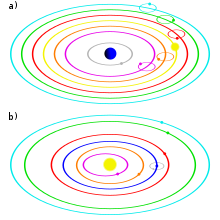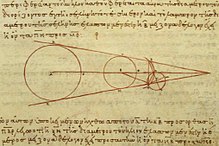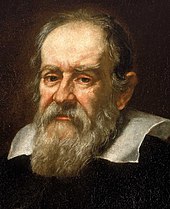Heliocentrism
The heliocentric worldview (Ancient Greek ἥλιος helios, German 'sun' and κέντρον kentron center), also called the Copernican worldview, is a worldview in which the sun is considered the resting center of the universe. The planets, including the Earth, move around the center, while the fixed stars are said to be attached to a stationary outer spherical shell. In this, the earth revolves around itself once a day and the moon moves around the earth once every month or so.
In its beginnings, the heliocentric view of the world goes back to the Greek astronomers Aristarchus of Samos and Seleucus of Seleucia, but it was not until the 16th century that Nicolaus Copernicus elaborated it in detail, and it was decisively improved in the 17th century by Johannes Kepler and then, above all, by Isaac Newton.
Thus it asserted itself against the geocentric view of the world prevailing since antiquity, in which the earth is not a moving planet but rests and represents the motionless centre around which the sun, moon, planets and fixed stars revolve. Although this corresponds to the direct perception of the movements of the celestial bodies, it makes the explanation of the small irregularities already observed in antiquity extraordinarily complicated and has also been refuted by direct measurements since the 18th century.
In the strict sense, the usual designation as heliocentric system applies only to the stage of development reached by Kepler, because with Copernicus (70 years earlier) the planets and even the sun itself still orbited around an imaginary point somewhat outside the sun, called the "middle sun", and with Newton (60 years later) already around the barycenter of the solar system, which usually lies somewhat outside the sun. At the same time, the modern idea matured that the universe as a whole has no centre at all.
Compared to the geocentric worldview, the heliocentric worldview was much simpler and yet paved the way for the first time to a considerably more accurate description and prediction of the positions of the sun, stars and planets. However, even at its inception it was in conflict with many religious ideas about the role of man and his place in the universe. The idea that the earth was not in the centre and that it was itself in motion was not acceptable for a long time. Thus, the heliocentric worldview also met with fierce resistance from the Christian churches (see, for example, the Galileo trial). The emergence and spread of the heliocentric worldview are closely linked to the rise of modern natural sciences and are therefore also referred to as the Copernican turn.

Schematic comparison: Geocentric (a) and heliocentric world view (b) Earth Moon Mercury Venus Sun Mars Jupiter Saturn
Precursor of the heliocentric world view
Ancient Greece
Little is known about what was thought in ancient Greece about a worldview that did not center on the earth. For the Pythagorean school from the 6th century BC onwards, fire was the most important element. Philolaos (5th century BC), for example, assumed that the sun, earth, and the other celestial bodies orbited a central fire located beneath the earth and therefore invisible. Aristotle (4th century B.C.) reported that "In the center, they (the Pythagoreans) say, is fire and the earth is one of the stars and produces night and day by moving in a circle around the center. " He rejected this worldview, however, giving reasons for a geocentric worldview, and thus remained determinative until the 17th century AD.
Aristarchus of Samos (3rd century BC), from whom a book with a geocentric world view has been preserved, is also said to have written a book with a heliocentric world view. In it the orbital motion of the earth is said to have appeared for the first time as a natural explanation of the intermittent retrograde motion of the planets. Aristarchus also knew that the stars would then have to show parallax. However, this was not observed at the time, which he explained by assuming that the stars were very far apart. Aristarchus also estimated the size of the moon and the distance of the earth from the moon and the sun. The calculations for the moon were acceptable, but for the sun he misestimated by many orders of magnitude. At the same time, his contemporary Eratosthenes was able to calculate the circumference of the Earth with approximate accuracy.
Seleucus of Seleucia (2nd century BC) is also said to have held a heliocentric worldview. When he lived, the consequences of a heliocentric worldview were probably already calculable, so that the worldview could be verified ("proven") on the basis of observations. More detailed information about Seleukos is not known.
In the second century A.D. Claudius Ptolemy developed a system that included an epicycle theory on a geocentric basis in order to reconcile astronomical observations with the Aristotelian principle of uniform motion. This theory envisaged for the moving celestial bodies such a complicated construction of up to 80 multi-step compound circular motions of fictitious points in space that it hardly seemed compatible with the Aristotelian precepts and yet still left much to be desired in terms of accuracy. Nevertheless, it was used almost unchanged for centuries to calculate the movements of the sun, moon, and planets.
India
The Indian astronomer and mathematician Aryabhata (476-550) assumed that the earth rotates on its own axis and discovered that the moon and planets reflect the light of the sun. It is believed that he held a heliocentric view of the world, because in his model for calculating the positions of the planets he gave the orbital periods for Venus and Mercury around the sun, not around the earth.
Islamic astronomy in the Middle Ages
Islamic astronomers in the Middle Ages stuck with the geocentric view of the world, but noticed the lack of agreement with observations. They recognized as a problematic weak point the introduction of the equant, a fictitious point off the center of the world, with the help of which in Ptolemy's epicycle theory non-uniform motions appear to the terrestrial observer as uniform; this hypothesis also contradicted the principle of uniform circular motion.
The Persian scientist Nasir ad-Din at-Tusi (1201-1274) solved this and other problems of the Ptolemaic system with the help of the Tusi pairs, which are two circular movements where one circle rolls on the inside of the other. At-Tusi showed that linear motions can also result from this, thereby incidentally refuting the Aristotelian doctrine of the irreconcilable difference between linear and circular motions.
The scientist Mu'ayyad ad-Din al-Urdi (c. 1250) developed the Urdi lemma, by means of which a circular motion can be made an eccentric circular motion by an epicycle. Urdi lemma and Tusi pair were later used in the Copernican model, but without reference to their discoverers.
Ibn ash-Shatir (1304-1375), in his treatise Kitab Nihayat as-Sulfi Tashih al-Usul, resolved the necessity of an equant by introducing an additional epicycle into the Ptolemaic system. In the same way, Copernicus later succeeded in constructing his model without an equant. Otherwise, however, Ibn ash-Shatir stuck to the geocentric system.

Aristarchus (3rd century B.C.): Calculations of the sizes of the earth, sun and moon (copy from the 10th century)

Tusi couples (Cardan circles) in a manuscript by Nasir ad-Din at-Tusi (13th century).
Reception
Already with Aristarch in the 3rd century B.C. the heliocentric worldview was classified as "anti-religious". This was also true in Christian Europe, which is why this worldview remained without significance until the 16th century AD.
After the 11th century, Arabic texts were increasingly translated into Latin in the Toledo school of translation. The Franciscan Bonaventure of Bagnoregio lectured on a heliocentric worldview contained therein in his Collationes in Hexaemeron 1273, interpreting it theologically to Christ as the center of creation. He was followed in the discussion by Nicholas of Oresme and Nicolaus Cusanus. Most scholars, however, saw in the worldview with a rotating earth or even an earth revolving around the sun the problem that people and objects should fall at an angle or even fly out into space; an object falling from a tower should not hit the ground exactly perpendicularly because of the eastward rotation of the earth, but should be deflected to the west. Also, the Bible seemed to contradict the heliocentric worldview by reporting that God once commanded the moon and sun to stand still Jos 10:12-13 LUT, not the earth, in the Israelites' battle against the Amorites.
Against the heliocentric worldview, the Catholic monastic order of the Dominicans demanded a teaching ban, which, however, did not prevail at first. In the 16th century, Protestants also expressed their firm opposition to the Copernican worldview. It is often said that Martin Luther himself, in a table conversation (1539), opposed it in no uncertain terms: "This fool wants to pervert the entire art of astronomy. " This, however, is probably a subsequent aggravation, for the most original source for this quotation says here only, "As does he who wishes to pervert the whole art of astronomy." Further, not a single statement on the heliocentric worldview is known from Luther.
As a compromise, Tycho developed a system in which Earth stood still and was orbited by the Sun and the Moon, while the other planets orbited the Sun, as in the Copernican system. Jesuit astronomers in Rome were initially skeptical of this system such as Christophorus Clavius, who commented that Tycho Brahe "confused all astronomy by wanting Mars closer than the Sun." When the Church became tougher on Copernican ideas after 1616, the Jesuits switched to Brahe's system. From 1633 the use of this system was obligatory.
Tycho, however, also strengthened the doubts about the prevailing world view, because he could not detect a measurable parallax either in the supernova of 1572 or in the comet of 1577 and concluded from this that both must be far outside the moon's orbit. According to the teachings of Aristotle at that time, celestial perfection should reign there, so that there should be no processes of creation and decay.
At this time, the physical views of Aristotle and thus the world view held by the church were called into doubt or even refuted by the first results of the beginning natural science in today's sense. In particular, Galileo Galilei should be mentioned with his experiments on free fall and oblique throw and his discoveries of the phases of Venus and the moons of Jupiter. The Catholic Church began to sternly defend the geocentric worldview. Pope Urban VIII had still approved the publication of Galileo's work Dialogue Concerning the Two Principal World Systems (i.e., the geocentric and heliocentric worldviews), but now opposed it.
In a much-publicized Inquisition trial, Galileo was accused of holding "...a false doctrine taught by many, namely, that the sun is immovable in the center of the world and that the earth moves." The final verdict was that he was guilty of "heresy". With the Galileo case, the conflict between the church's claim to authority and free science was raised for the first time beyond the church and into social consciousness.
Triggered by the general recognition that Newton's results had won in the scientific world, Pope Benedict XIV lifted the ban on works that advocated the heliocentric worldview on April 17, 1757. On September 11, 1822, the Congregation of the Roman and General Inquisition ruled that the printing and publication of works depicting the motion of the planets and sun in accordance with the view of modern astronomers was permitted. In 2018, a Foucault pendulum was hung in the former Catholic Dominican Church in the city of Münster in order to also make visible here "the rotation of the earth first demonstrated in a pendulum experiment in 1851 by the French physicist Léon Foucault".
After the idea of an infinite universe had already been expressed in antiquity (Leucippus, Democritus, Lucretius), Nicholas of Cusa showed in the 15th century that in an infinite universe the earth cannot be a centre, just as little as any other celestial body, thus excluding both a geocentric and a heliocentric world view. These views were later also held by Thomas Digges and Giordano Bruno and became accepted as doctrine in the course of the 18th and 19th centuries, even before galaxies outside the Milky Way were discovered in the 20th century. The heliocentric world view was gradually replaced by the cosmological principle from about 1930.
The cosmological principle states that in principle there is no place that is distinguished before another, thus also no center. World views that emphasize a particular place in the universe are considered outdated. Together with the isotropy of the universe, i.e. that no direction is distinguished, the cosmological principle forms the cornerstone of the standard model of cosmology, which is supported by observation of the observable universe.
However, the cosmological principle is only applicable on large scales, spanning millions of light years. In smaller systems such as a galaxy (typically a few 100,000 light years in size) or our solar system (less than 1/1000 light year in size), excellent points can be specified. Thus, while the Sun is not the center of the universe, it does form the center of the solar system, since its center of mass is never more than about one solar radius from the surface of the Sun, and often lies within it.
Likewise, from a physical point of view, according to general relativity, every free-falling system is equal and a change from the geocentric to the heliocentric world view is only a transformation of coordinates. Since the sun is closest to the center of gravity of the solar system, the heliocentric reference system is almost identical to the center of gravity system and therefore often serves as a simple reference system for the representation of processes in the solar system.

Galileo Galilei (portrait by Justus Sustermans 1636)

Geocentric and heliocentric system symbolized by food in discussion (painting by Cornelis Troost, 1741)

World system of Tycho Brahe: The earth is in the center of the world, but the other planets move around the sun.
Questions and Answers
Q: What is heliocentrism?
A: Heliocentrism is the idea that the Earth and other planets revolve around the Sun, which is the center of the solar system.
Q: Who proposed heliocentrism?
A: Many people proposed heliocentrism, such as Aristarchus of Samos from ancient Greece, but Nicolaus Copernicus was the first to think of good reasons why it is true.
Q: What did most people believe before Copernicus?
A: Before Copernicus, most people thought that the Sun and the other planets revolved around the Earth (this was called geocentrism). This is because if you stand on Earth, it looks like the Sun and stars are moving across the sky.
Q: What did Copernicus explain in his book De revolutionibus orbium coelestium ("On The Revolutions Of The Heavenly Spheres")?
A: In his book De revolutionibus orbium coelestium ("On The Revolutions Of The Heavenly Spheres"), Copernicus explained why certain things happen in relation to planetary movement that do not make sense if one believes that Earth is at the center of our Solar System. He gave his reasons for thinking that instead, it should be believed that Sun was at its center.
Q: Who made further advances after Copernicus?
A: Other astronomers who made further advances after Copernicus were Johannes Kepler and Galileo Galilei. For example, Kepler showed that planets do not orbit in perfect circles, and Galileo built very good telescopes that helped to confirm heliocentric model.
Q: Did Copernicus also think sun was at center of universe?
A: Yes, initially he thought so too but we now know this to be incorrect as we understand today that Sun is part of Milky Way galaxy which itself is just one out billions of galaxies in universe.
Search within the encyclopedia